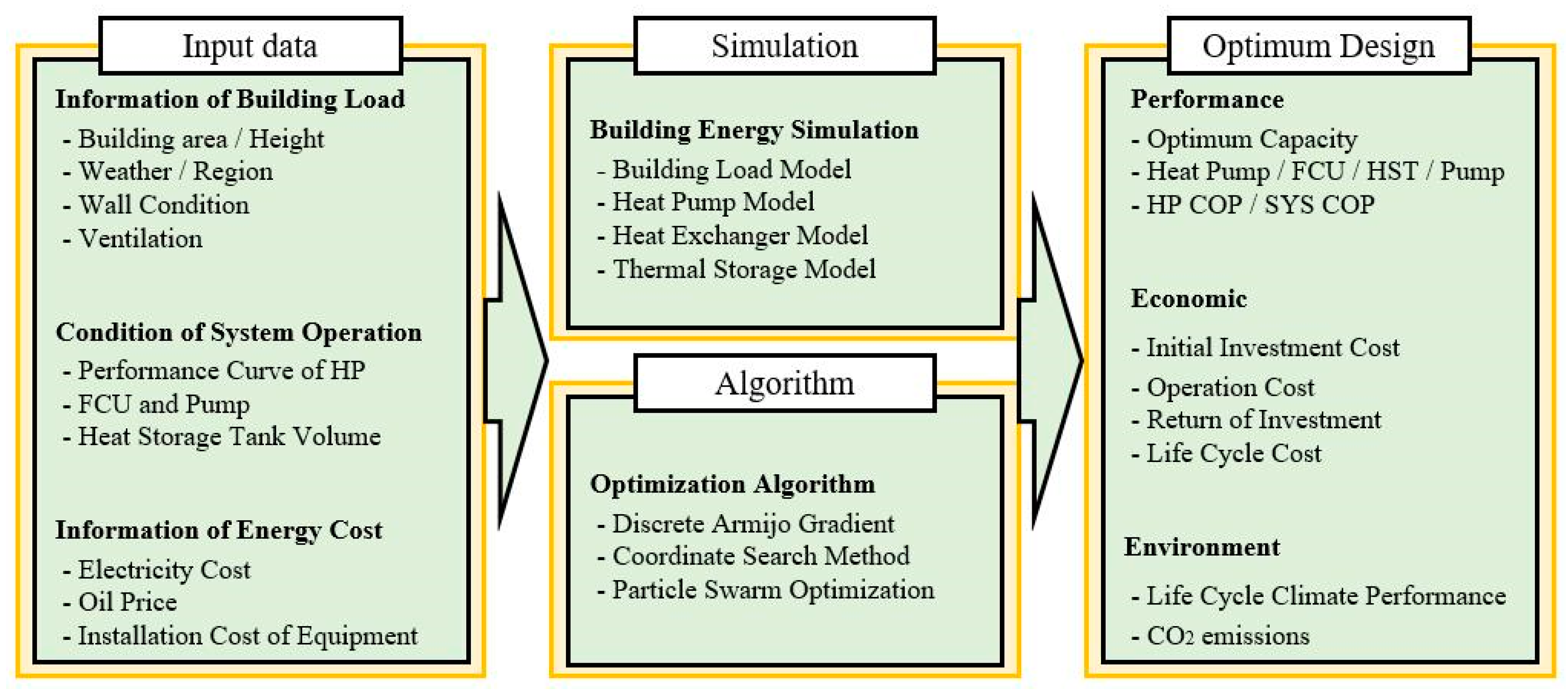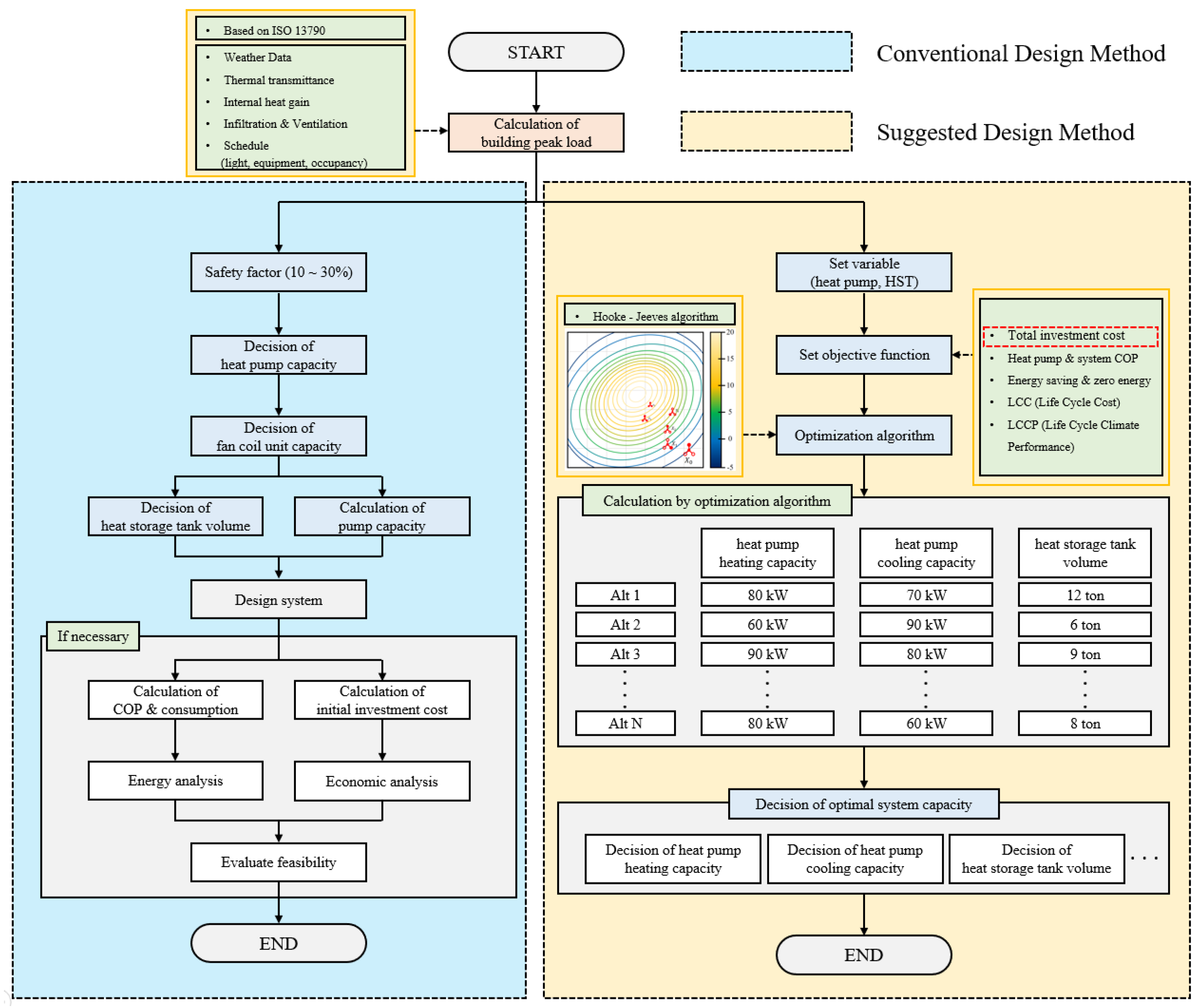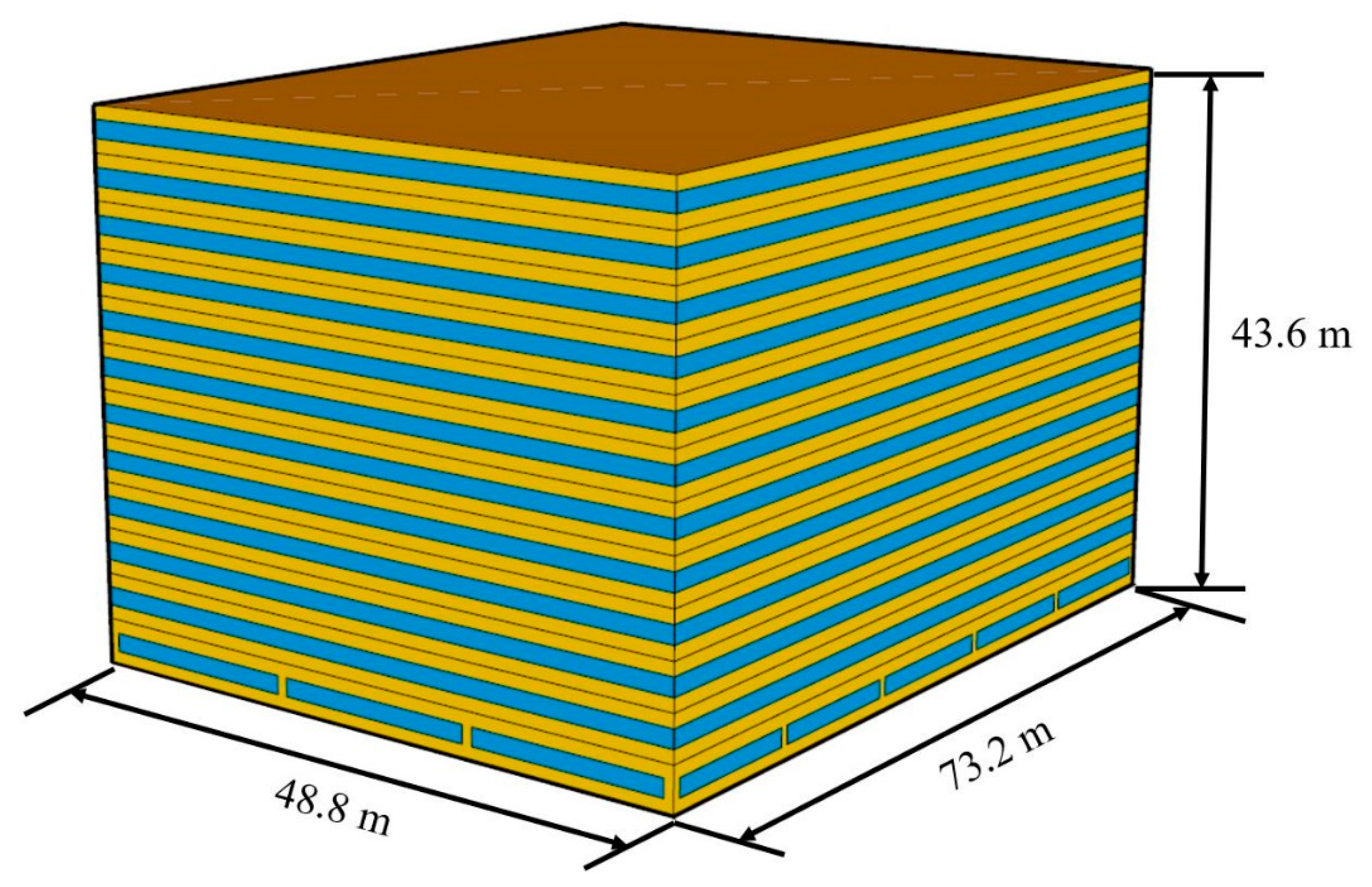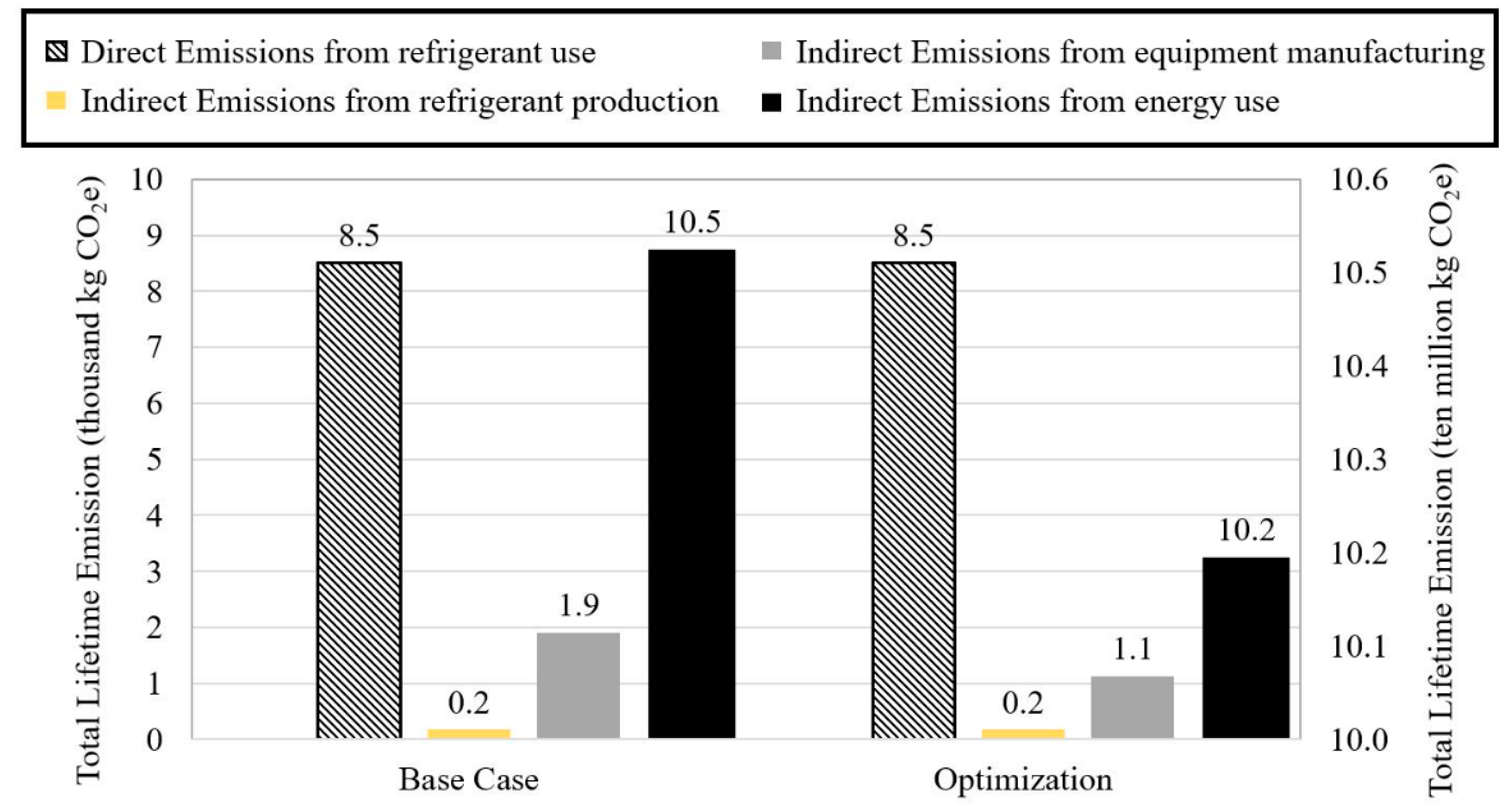Development of Design Method for River Water Source Heat Pump System Using an Optimization Algorithm
Abstract
:1. Introduction
2. Materials and Methods
2.1. Natural Water Source Heat Pump System
- The Lotte World Tower in South Korea uses raw-water pipes for heating and cooling; approximately 10–20% of the heating and cooling energy is managed by the 3000-RT NWSHP system that saves approximately 700 million in energy cost annually [15].
- Cooling and heating are conducted to office buildings and 100 houses of approximately 278,000 m2 in a district located in Hakozaki, Japan using river water. The river water originates from the Sumida River, which is characterized by average temperatures of approximately 25 and 8 °C in summer and winter, respectively [15].
- Cornell University in the USA developed and utilized a 20000-RT cooling and heating system using pond water with a temperature range of 5–13 °C at a depth of 76 m that reduces the energy consumption by approximately 80% [16].
2.2. Research Method
3. Simulation Model
3.1. Building Load Model
3.2. Dynamic Energy Simulation
3.3. System Operation Method
3.4. Optimization Algorithm
3.5. Optimization Conditions
3.6. Economic Analysis
3.7. Life Cycle Climate Performance
4. Results and Discussion
4.1. Result of Optimization
4.2. Result of Energy Performance
4.3. Result of Economic Analysis
4.4. Result of Life Cycle Climate Performance
5. Conclusions
- The initial investment and annual operation costs were reduced by 59% and 11%, respectively, by applying the optimization design method to the RWSHP system. The optimization design method decreased the total cost by 24% compared to the existing design method.
- The optimization design method decreased the CO2 emission by approximately 4% compared to the existing design method for the RWSHP system. The LCCP analysis was only evaluated for HP. However, should all system components be included in the LCCP analysis, the difference in CO2 emission is estimated to further increase.
- The performance of the RWSHP system was similar for both the optimization and existing design methods. However, the optimization design method could significantly improve the economics and reduce CO2 emissions.
Author Contributions
Funding
Institutional Review Board Statement
Informed Consent Statement
Data Availability Statement
Conflicts of Interest
| GWP of atmospheric reaction product of the refrigerant [kg CO2e/kg] | |
| Cost of heat pump [KRW] | |
| Cost of heat pump per kW [KRW/kW] | |
| Cost of heat storage tank [KRW] | |
| Cost of heat storage tank per cubic meter [KRW/m3] | |
| Energy cost per year [KRW/year] | |
| Energy cost per month [KRW/month] | |
| Energy cost for 20 years [KRW] | |
| Present worth of annuity factor during n years | |
| COP of heat pump | |
| Heat transfer rate of heat pump [kJ/h] | |
| Power of heat pump [kJ/h] | |
| COP of system | |
| Heat transfer rate of system [kJ/h] | |
| Power of system [kJ/h] | |
| Refrigerant charge [kg] | |
| Average lifetime of equipment [years] | |
| Annual leakage rate [per year] | |
| End of life refrigerant leakage | |
| Global warming potential [kg CO2/kg] | |
| GWP of atmospheric degradation product of the refrigerant [kg CO2/kg] | |
| Annual energy consumption [kWh] | |
| CO2 produced/kWh [kg CO2/kg] | |
| Mass of unit [kg] | |
| CO2e produced/material [kg CO2/kg] | |
| Mass of recycled material [kg] | |
| CO2e produced/recycled material [kg CO2/kg] | |
| Refrigerant manufacturing emissions [kg CO2/kg] | |
| Refrigerant disposal emissions [kg CO2/kg] |
| IEA | International Energy Agency |
| PWAF | Present worth of annuity factor |
| PNNL | Pacific Northwest National Laboratory |
| ASHRAE | American Society of Heating, Refrigeration and Air-conditioning Engineers |
| RWSHP | River—water source heat pump |
| NWSHP | Natural water source heat pump |
| LCC | Life cycle cost |
| HP | heat pump |
| HST | Heat storage tank |
| FCU | Fan coil unit |
| LCCP | Life cycle climate performance |
| GHG | Greenhouse gas |
| LWT | Leaving water temperature |
| COP | Coefficient of performance |
| GWP | Global Warming Potential |
| IIR | International institute of refrigeration |
References
- International Energy Agency (IEA). World Energy Outlook; International Energy Agency (IEA): Paris, France, 2019. [Google Scholar]
- Korea Energy Agency. Summary of the Results of New and Renewable Energy Dissemination Statistics; Korea Energy Agency: Yongin, Korea, 2019. [Google Scholar]
- Cho, Y.; Yun, R. A raw water source heat pump air-conditioning system. Energy Build. 2011, 43, 3068–3073. [Google Scholar] [CrossRef]
- Zheng, W.; Ye, T.; You, S.; Zhang, H. The thermal performance of seawater-source heat pump systems in areas of severe cold during winter. Energy Convers. Manag. 2015, 90, 166–174. [Google Scholar] [CrossRef]
- Wang, Z.; Wang, L.; Ma, A.; Liang, K.; Song, Z.; Feng, L. Performance evaluation of ground water-source heat pump system with a fresh air pre-conditioner using ground water. Energy Convers. Manag. 2019, 188, 250–261. [Google Scholar] [CrossRef]
- Jung, Y.; Kim, J.; Kim, H.; Yun, R.; Park, C.; Nam, Y.; Cho, H.; Lee, H. Comprehensive feasibility investigation of river source heat pump systems in terms of life cycle. Appl. Therm. Eng. 2021, 188, 116655. [Google Scholar] [CrossRef]
- Jung, Y.; Kim, J.; Kim, H.; Nam, Y.; Cho, H.; Lee, H. Comprehensive multi-criteria evaluation of water source heat pump systems in terms of building type, water source, and water intake distance. Energy Build. 2021, 236, 110765. [Google Scholar] [CrossRef]
- Oh, S.; Cho, Y.; Yun, R. Raw-water source heat pump for a vertical water treatment building. Energy Build. 2014, 68, 321–328. [Google Scholar] [CrossRef]
- Du, B.; Gao, J.; Zeng, L.; Su, X.; Zhang, X.; Yu, S.; Ma, H. Area optimization of solar collectors for adsorption desalination. Sol. Energy 2017, 157, 298–308. [Google Scholar] [CrossRef]
- Mi, P.; Ma, L.; Zhang, J. Integrated optimization study of hot water supply system with multi-heat-source for the public bath based on PVT heat pump and water source heat pump. Appl. Therm. Eng. 2020, 176, 115146. [Google Scholar] [CrossRef]
- Moon, H.; Kim, H.; Nam, Y. Study on the Optimum Design of a Ground Heat Pump System Using Optimization Algorithms. Energies 2019, 12, 4033. [Google Scholar] [CrossRef] [Green Version]
- Guo, X.; Shu, H.; Gao, J.; Xu, F.; Cheng, C.; Sun, Z.; Xu, D. Volume design of the heat storage tank of solar assisted water-source heat pump space heating system. Procedia Eng. 2017, 205, 2691–2697. [Google Scholar] [CrossRef]
- Liu, Y.; Zhou, W.; Luo, X.; Wang, D.; Hu, X.; Hu, L. Design and operation optimization of multi-source complementary heating system based on air source heat pump in Tibetan area of Western Sichuan, China. Energy Build. 2021, 242, 110979. [Google Scholar] [CrossRef]
- International Institute of Refrigeration. Guideline for Life Cycle Climate Performance; International Institute of Refrigeration: Paris, France, 2016. [Google Scholar]
- Jung, J.-W.; Nam, J.-S.; Kim, H.-S. Cases of Water Source Energy Utilization of Sewage and River water in Korea. Water Future 2017, 50, 50–58. [Google Scholar]
- Jung, J.; Nam, J.; Jung, S.; Kim, J.; Kim, H.S. Feasibility Study on the Use of River Water Hydrothermal Energy in Korea: (1) Estimation of the Permitted Standard Discharge and Determination of the Potential Water Intake Area. New Renew. Energy 2018, 14, 27–37. [Google Scholar] [CrossRef]
- Office of Energy Efficiency & Renewable Energy. Available online: http://www.energy.gov/eere/office-energy-efficiency-renewable-energy (accessed on 18 October 2018).
- ASHRAE 90.1; Energy Standard for Buildings Except Low-Rise Residential Buildings. ASHRAE: Atlanta, GA, USA, 2013.
- ASHRAE 90.1; Energy Standard for Buildings Except Low-Rise Residential Buildings. ASHRAE: Atlanta, GA, USA, 2004.
- ASHRAE Standard 55; Thermal Environment Conditions for Human Occupancy. ASHRAE: Atlanta, GA, USA, 2004.
- ASHRAE Standard 62.1; Ventilation for Acceptable Indoor Air Quality. ASHRAE: Atlanta, GA, USA, 2010.
- Ministry of Land, Infrastructure and Transport in Korea. Green Buildings Construction Support Act. 2020. Available online: https://elaw.klri.re.kr/ (accessed on 26 May 2022).
- Climate Master. Available online: https://www.climatemaster.com/ (accessed on 26 May 2022).
- Carrier. Available online: http://www.carrier.co.kr/index.asp (accessed on 26 May 2022).
- Kavanaugh, S.; Rafferty, K. Geothermal Heating and Cooling—Design of Ground-Source Heat Pump Systems; ASHRAE: Atlanta, GA, USA, 2016. [Google Scholar]
- Oh, S.-H.; Yun, R.; Cho, Y. Cooling and Heating Operation Characteristics of Raw-water Source Heat Pump and Air Source Heat Pump in Water Treatment Facility. Korean J. Air-Cond. Refrig. Eng. 2013, 25, 386–391. [Google Scholar]
- Si, B.; Tian, Z.; Jin, X.; Zhou, X.; Shi, X. Ineffectiveness of optimization algorithms in building energy optimization and possible causes. Renew. Energy 2019, 134, 1295–1306. [Google Scholar] [CrossRef]
- Korean on-Line E-Procurement System. Available online: http://shopping.g2b.go.kr (accessed on 26 May 2022).
- Korea Electric Power Corporation. Available online: https://home.kepco.co.kr/kepco/main.do (accessed on 26 May 2022).












| Author | Optimization Factor | Performance Analysis | Economic Analysis | CO2 Emission Analysis |
|---|---|---|---|---|
| Du et al. [9] | Solar collector area | O | O | X |
| Mi et al. [10] | Number of photovoltaic solar thermal, heat pump, and operation time | O | O | X |
| Moon et al. [11] | Ground heat exchanger, heat pump, and heat storage tank volume | O | O | X |
| Guo et al. [12] | Heat storage tank volume | O | X | X |
| Liu et al. [13] | Heat sink arrangement | O | O | O |
| Location | Busan, South Korea | Reference |
|---|---|---|
| Building Model | Large-scale office | PNNL |
| Set Temperature (°C) | Heating Season: 21 | ASHRAE 90.1-2004 |
| Cooling Season: 24 | ||
| Floor Area (m2) | 3567 | PNNL |
| Infiltration (1/h) | 0.0002 | ASHRAE 90.1-2004 |
| Operation Season | Heating: January–April & November–December | |
| Cooling: May–October | ||
| Internal Heat Gain (W/m2) | People: 70 | ASHRAE 55-2004 |
| Lights: 11.84 | ASHRAE 90.1-2004 | |
| Equipment: 8.07 | ||
| U-Value (W/m2·K) | Ground Floor: 0.250 | Energy Saving Design Standards for Buildings in Korea |
| External Walls: 0.32 | ||
| Roof: 0.18 | ||
| Internal Roof: 0.35 | ||
| Windows: 1.8 |
| Component | Parameter | Value |
|---|---|---|
| Heat Pump | Type | Water to Water Heat Pump |
| Heating Capacity | 54 kW | |
| Power Consumption (Heating) | 13.5 kW | |
| Cooling Capacity | 42 kW | |
| Power Consumption (Cooling) | 10.5 kW | |
| Source/Load Specific Heat | 4.19 kJ/ (kg · K) | |
| Heat Storage Tank | Tank Volume | 10 m3 |
| Fan Coil Unit | Heating Capacity | 65 kW |
| Cooling Capacity | 50.4 kW | |
| Volumetric Air Flow Rate | 2475 L/s | |
| Power Consumption | 3 kW | |
| Pump | Maximum Flow Rate | 9000 kg/h |
| Power Consumption | 1 kW |
| Component | Parameter | Initial Value | Minimum Value | Maximum Value | Step Value |
|---|---|---|---|---|---|
| Heat Pump | Cooling Capacity | 42 kW | 21 kW | 84 kW | 1 kW |
| Heating Capacity | 54 kW | 27 kW | 108 kW | ||
| Heat Storage Tank | Volume | 10 m3 | 0.1 m3 | 20 m3 | 1 m3 |
| Component | Parameter | Cost/Value | |
|---|---|---|---|
| Initial Investment Cost | Heat Pump | Cooling Capacity | 198,434 won/kW |
| Heating Capacity | |||
| Heat Storage Tank | Volume | 2,500,000 won/m3 | |
| Annual Operation Cost | Heat Pump FCU Pump | Power Consumption | 100 won/kW |
| Total Cost | Initial Investment Cost + 20 years of Operational Costs | ||
| Heat Pump Cooling Capacity | Heat Pump Heating Capacity | Heat Storage Tank Volume | |
|---|---|---|---|
| Original | 42 kW | 54 kW | 10 m3 |
| Optimization (Hooke–Jeeves Algorithm) | 31.3 kW | 42.3 kW | 2.75 m3 |
| Initial Investment Cost (won) | Annual Operation Cost (20 Years) (won) | Total Cost (won) | |
|---|---|---|---|
| Original | 34,504,000 | 95,651,840 | 130,155,840 |
| Optimization (Hooke–Jeeves Algorithm) | 14,157,688 | 85,148,146 | 99,305,834 |
| Category | Notation | Base Case | Optimization | Unit |
|---|---|---|---|---|
| Refrigerant | HFC-410a | - | ||
| Refrigerant Charge | C | 6.8 | 2.49 | kg |
| Average Lifetime of Equipment | L | 10 | Years | |
| Annual Leakage Rate | ALR | 5% | Per year | |
| End of Life Refrigerant Leakage | EOL | 15% | - | |
| Global Warming Potential | GWP | 1924 | kg CO2/kg | |
| Annual Energy Consumption | AEC | 35,128 | 30,811 | kWh |
| CO2 Produced/kWh | EM | 0.46 | kg CO2e | |
| Mass of Unit | M | Steel: 164.7 Aluminum: 43.0 Copper: 68.0 Plastics: 82.3 | Steel: 151.3 Aluminum: 39.5 Copper: 62.5 Plastics: 75.7 | kg |
| Refrigerant Manufacturing Emissions | RFM | 0.46 | kg CO2/kg | |
| Refrigerant Disposal Emissions | RFD | - | kg CO2/kg | |
Publisher’s Note: MDPI stays neutral with regard to jurisdictional claims in published maps and institutional affiliations. |
© 2022 by the authors. Licensee MDPI, Basel, Switzerland. This article is an open access article distributed under the terms and conditions of the Creative Commons Attribution (CC BY) license (https://creativecommons.org/licenses/by/4.0/).
Share and Cite
Kwon, Y.; Bae, S.; Nam, Y. Development of Design Method for River Water Source Heat Pump System Using an Optimization Algorithm. Energies 2022, 15, 4019. https://doi.org/10.3390/en15114019
Kwon Y, Bae S, Nam Y. Development of Design Method for River Water Source Heat Pump System Using an Optimization Algorithm. Energies. 2022; 15(11):4019. https://doi.org/10.3390/en15114019
Chicago/Turabian StyleKwon, Youngsik, Sangmu Bae, and Yujin Nam. 2022. "Development of Design Method for River Water Source Heat Pump System Using an Optimization Algorithm" Energies 15, no. 11: 4019. https://doi.org/10.3390/en15114019
APA StyleKwon, Y., Bae, S., & Nam, Y. (2022). Development of Design Method for River Water Source Heat Pump System Using an Optimization Algorithm. Energies, 15(11), 4019. https://doi.org/10.3390/en15114019





